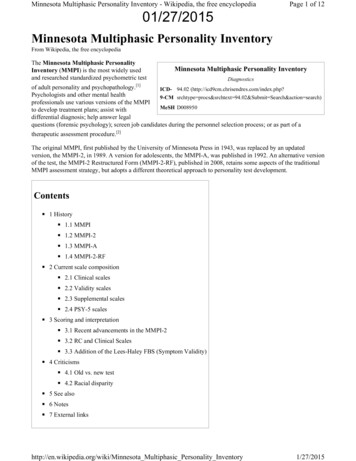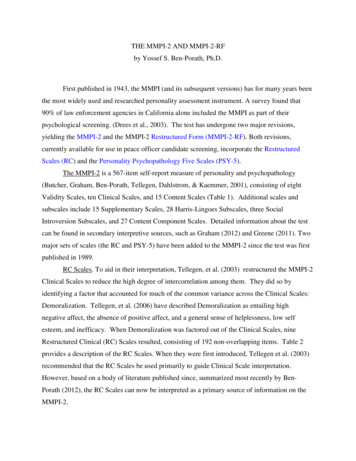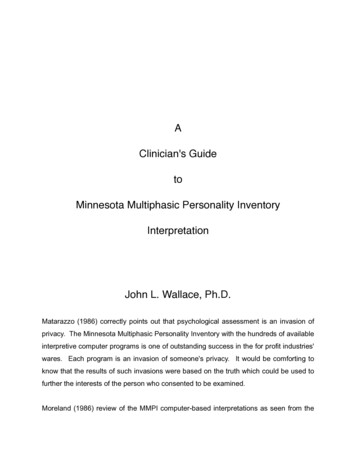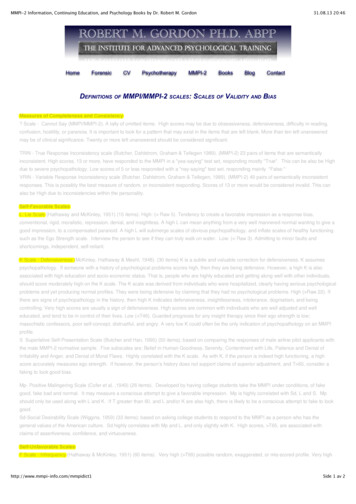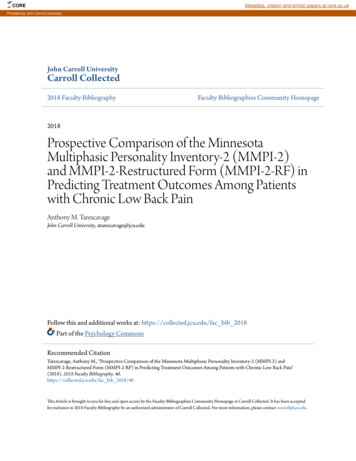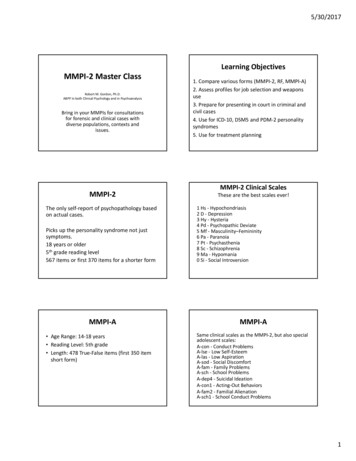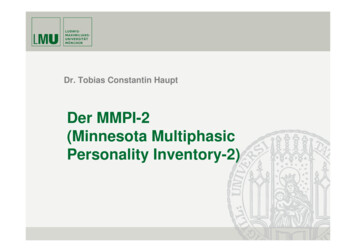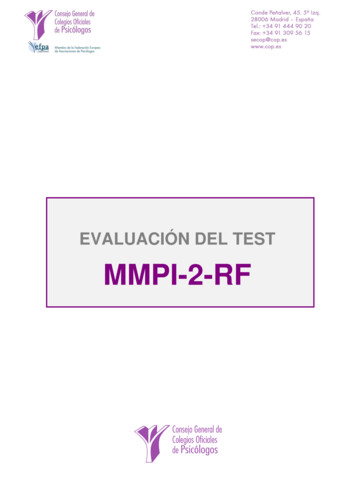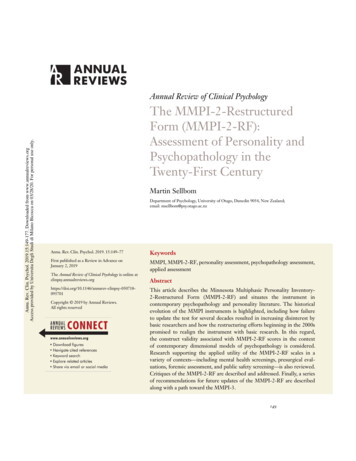
Transcription
CP15CH07 SellbomARjats.clsApril 12, 201911:31Annu. Rev. Clin. Psychol. 2019.15:149-177. Downloaded from www.annualreviews.orgAccess provided by Universita Degli Studi di Milano Bicocca on 03/28/20. For personal use only.Annual Review of Clinical PsychologyThe MMPI-2-RestructuredForm (MMPI-2-RF):Assessment of Personality andPsychopathology in theTwenty-First CenturyMartin SellbomDepartment of Psychology, University of Otago, Dunedin 9054, New Zealand;email: msellbom@psy.otago.ac.nzAnnu. Rev. Clin. Psychol. 2019. 15:149–77KeywordsFirst published as a Review in Advance onJanuary 2, 2019MMPI, MMPI-2-RF, personality assessment, psychopathology assessment,applied assessmentThe Annual Review of Clinical Psychology is online /annurev-clinpsy-050718095701Copyright 2019 by Annual Reviews.All rights reservedAbstractThis article describes the Minnesota Multiphasic Personality Inventory2-Restructured Form (MMPI-2-RF) and situates the instrument incontemporary psychopathology and personality literature. The historicalevolution of the MMPI instruments is highlighted, including how failureto update the test for several decades resulted in increasing disinterest bybasic researchers and how the restructuring efforts beginning in the 2000spromised to realign the instrument with basic research. In this regard,the construct validity associated with MMPI-2-RF scores in the contextof contemporary dimensional models of psychopathology is considered.Research supporting the applied utility of the MMPI-2-RF scales in avariety of contexts—including mental health screenings, presurgical evaluations, forensic assessment, and public safety screening—is also reviewed.Critiques of the MMPI-2-RF are described and addressed. Finally, a seriesof recommendations for future updates of the MMPI-2-RF are describedalong with a path toward the MMPI-3.149
CP15CH07 SellbomARjats.clsApril 12, 201911:31ContentsAnnu. Rev. Clin. Psychol. 2019.15:149-177. Downloaded from www.annualreviews.orgAccess provided by Universita Degli Studi di Milano Bicocca on 03/28/20. For personal use only.INTRODUCTION . . . . . . . . . . . . . . . . . . . . . . . . . . . . . . . . . . . . . . . . . . . . . . . . . . . . . . . . . . . . . .OVERVIEW OF THE MMPI-2-RF . . . . . . . . . . . . . . . . . . . . . . . . . . . . . . . . . . . . . . . . . . . . . .HISTORY AND EVOLUTION OF THE MMPI INSTRUMENTS . . . . . . . . . . . . . . .An Early Paradigm Shift . . . . . . . . . . . . . . . . . . . . . . . . . . . . . . . . . . . . . . . . . . . . . . . . . . . . . . . .A Second MMPI Paradigm Shift . . . . . . . . . . . . . . . . . . . . . . . . . . . . . . . . . . . . . . . . . . . . . . . .CONSTRUCT VALIDITY OF MMPI-2-RF SCALE SCORES . . . . . . . . . . . . . . . . . . . .Assessment of Response Bias . . . . . . . . . . . . . . . . . . . . . . . . . . . . . . . . . . . . . . . . . . . . . . . . . . . .Mapping the MMPI-2-RF onto Contemporary Psychopathologyand Personality Models . . . . . . . . . . . . . . . . . . . . . . . . . . . . . . . . . . . . . . . . . . . . . . . . . . . . . . .APPLIED PERSONALITY ASSESSMENT WITH THE MMPI-2-RF . . . . . . . . . . . .Mental Health Evaluations . . . . . . . . . . . . . . . . . . . . . . . . . . . . . . . . . . . . . . . . . . . . . . . . . . . . . .Presurgical Psychological Evaluations . . . . . . . . . . . . . . . . . . . . . . . . . . . . . . . . . . . . . . . . . . . .Forensic Psychological Evaluations . . . . . . . . . . . . . . . . . . . . . . . . . . . . . . . . . . . . . . . . . . . . . .Evaluating Public Safety Personnel . . . . . . . . . . . . . . . . . . . . . . . . . . . . . . . . . . . . . . . . . . . . . .Summary . . . . . . . . . . . . . . . . . . . . . . . . . . . . . . . . . . . . . . . . . . . . . . . . . . . . . . . . . . . . . . . . . . . . . . .CRITICISMS OF THE MMPI-2-RF AND ASSOCIATED RESPONSES . . . . . . . . .Item Coverage and Missing Information . . . . . . . . . . . . . . . . . . . . . . . . . . . . . . . . . . . . . . . . .Psychometric Performance of the Validity Scales . . . . . . . . . . . . . . . . . . . . . . . . . . . . . . . . .Psychometric Performance of the Specific Problems Scales . . . . . . . . . . . . . . . . . . . . . . .Sensitivity to Psychopathology . . . . . . . . . . . . . . . . . . . . . . . . . . . . . . . . . . . . . . . . . . . . . . . . . .Summary of Criticisms . . . . . . . . . . . . . . . . . . . . . . . . . . . . . . . . . . . . . . . . . . . . . . . . . . . . . . . . . .CONCLUSIONS AND FUTURE DIRECTIONS . . . . . . . . . . . . . . . . . . . . . . . . . . . . . . . 67167168168168INTRODUCTIONPersonality (or more accurately, psychopathology) assessment has been an integral part of clinicalpsychology practice spanning a full century (e.g., Butcher 2010). And for the past eight decades, theMinnesota Multiphasic Personality Inventory (MMPI; Hathaway & McKinley 1943) has been inthe forefront, in terms of both scientific inquiry and applied clinical use. Unfortunately, for reasonsthat will be described in detail, the MMPI eventually fell into disfavor among basic psychopathology researchers owing to the lack of theoretical advancements, but developments during the past15 years and publication of the MMPI-2-Restructured Form (MMPI-2-RF; Ben-Porath & Tellegen 2008) in 2008 have begun to realign this instrument with contemporary psychopathologydevelopments. This article describes the MMPI-2-RF in detail, discusses the historical evolutionof the MMPI instruments, highlights both achievements in construct validity and applied assessment research, discusses (and addresses) some criticisms of the test, and finally, recommends apath forward.OVERVIEW OF THE MMPI-2-RFThe MMPI-2-RF is a 338-item (true/false), multiscale, self-report inventory that measures a widerange of psychopathology symptoms and maladaptive personality traits. The instrument was developed by Professors Yossef Ben-Porath and Auke Tellegen as a psychometrically improved andmore efficient alternative to the MMPI-2. The MMPI-2-RF items are a subset of the 567 MMPI-2item pool, and as a result, continued reliance on the MMPI-2 normative data has been possible. In150Sellbom
Annu. Rev. Clin. Psychol. 2019.15:149-177. Downloaded from www.annualreviews.orgAccess provided by Universita Degli Studi di Milano Bicocca on 03/28/20. For personal use only.CP15CH07 SellbomARjats.clsApril 12, 201911:31the 10 years that have passed since the MMPI-2-RF was released, it has become a frequently usedand highly recommended test across a number of settings, including (but not limited to) mentalhealth, medical, forensic, and prison, as well as for public safety personnel (see Ben-Porath 2012;Corey & Ben-Porath 2018; Sellbom & Wygant 2018).The 338 MMPI-2-RF items aggregate onto 51 individual scales. Nine of these, the Validity Scales, measure various forms of response styles that, when excessive, could invalidate a testprotocol. The remaining 42 scales measure substantive clinical content. Most of these scales areorganized into a hierarchy that reflects both content breadth and interpretive organization. Morespecifically, this hierarchy of scales includes the three Higher-Order (H-O) Scales on the first tier,the nine Restructured Clinical (RC) Scales at the mid-tier level, and the 23 Specific Problems(SP) Scales at the bottom. Parallel to this hierarchy are the Personality Psychopathology Five(PSY-5) Scales, Revised, which are dimensional measures of personality pathology, and the twoInterest Scales. Table 1 lists the 51 MMPI-2-RF scales and provides a brief description of each.Readers are referred to Ben-Porath (2012) for a more detailed discussion of the underlying psychological constructs assessed by these scales.The nine Validity Scales measure various forms of response bias that can broadly be dividedinto three domains: non-content-based responding, overreporting, and underreporting (see, e.g.,Ben-Porath 2013 for a thorough description of these concepts). Non-content-based responsebias refers to unintentional or intentional responding that manifests as unscorable; random, inconsistent, or careless; or indiscriminant fixed (acquiescent or counteracquiescent) responding.The overreporting scales measure intentional or unintentional exaggeration or fabrication of psychopathology symptoms, as well as noncredible somatic and cognitive responding. The two underreporting scales assess overly virtuous responding (or positive impression management) and anexaggeration of psychological adjustment and resilience.The three H-O Scales, Emotional/Internalizing Dysfunction (EID), Thought Dysfunction(THD), and Behavioral/Externalizing Dysfunction (BXD), index broadband psychopathologyconstructs of, respectively, internalizing, thought disorder, and externalizing. They map ontobroader level dimensions that have been identified in a wide range of psychopathology research(see, e.g., Kotov et al. 2017). At the top of the MMPI-2-RF interpretive hierarchy, they reflectgeneral and pervasive dysfunction in their respective areas.The nine RC Scales are identical to their MMPI-2 counterparts (Tellegen et al. 2003). Unlikethe original MMPI Clinical Scales, the RC Scales reflect transdiagnostic, dimensional psychological constructs rather than psychiatric syndromes. The 23 SP Scales, the most narrowband symptom and trait measures on the instrument, are organized into four thematic domains: Somatic/Cognitive, Internalizing, Externalizing, and Interpersonal, which also reflect the general interpretive organization of the instrument. The two Interest Scales [Aesthetic–Literary (AES) andMechanical–Physical (MEC)] primarily measure personality and attitudinal constructs rather thanclinical symptoms or traits.Finally, the five PSY-5 Scales are revised versions of their MMPI-2 counterparts. They operationalize the PSY-5 constructs originally articulated by Harkness & McNulty (1994). Morespecifically, they represent dimensional personality traits with an abnormal range and are presented as a dimensional alternative to the categorical personality disorder framework that hasdominated the Diagnostic and Statistical Manual of Mental Disorders (DSM). The PSY-5 constructsand associated MMPI-2-RF scales align well with the trait domains included in the AlternativeModel for Personality Disorders (AMPD; Am. Psychiatr. Assoc. 2013) in Section III of the DSM-5(Anderson et al. 2013, 2015a); for a more detailed analysis of this overlap, see the section Mappingthe MMPI-2-RF onto Contemporary Psychopathology and Personality Models.www.annualreviews.org The MMPI-2-Restructured Form151
CP15CH07 SellbomARjats.clsApril 12, 201911:31Table 1 Minnesota Multiphasic Personality Inventory-2-Restructured Form scales, abbreviations, and briefdescriptionsScaleAbbreviationGeneral descriptionAnnu. Rev. Clin. Psychol. 2019.15:149-177. Downloaded from www.annualreviews.orgAccess provided by Universita Degli Studi di Milano Bicocca on 03/28/20. For personal use only.Validity ScalesVariable Response InconsistencyVRIN-rInconsistent respondingTrue Response InconsistencyTRIN-rIndiscriminant fixed respondingInfrequent ResponsesF-rOverreporting validity scale based on rare responses in the generalpopulationInfrequent PsychopathologyResponsesFp-rOverreporting validity scale based on rare responses in general andpsychiatric populationsInfrequent Somatic ResponsesFsOverreporting validity scale based on rare somatic complaints ingeneral and medical patient populationsSymptom ValidityFBS-rOverreporting validity scale based on noncredible somatic andcognitive complaintsResponse BiasRBSOverreporting validity scale associated with failure on performancevalidity testsUncommon VirtuesL-rUnderreporting validity scale based on rarely claimed moral attributesor activitiesAdjustment ValidityK-rUnderreporting validity scale describing an avowal of goodpsychological adjustmentHigher-Order ScalesEmotional/Internalizing DysfunctionEIDPervasive problems associated with mood and affectThought DysfunctionTHDPervasive problems with disordered thinkingBehavioral/Externalizing DysfunctionBXDPervasive problems with undercontrolled or acting-out behaviorDemoralizationRCdGeneral emotional distress, unhappiness, and dissatisfactionSomatic ComplaintsRC1Preoccupation with various types of health complaintsLow Positive EmotionsRC2Attenuated positive emotional experiences, significant tial beliefs expressing a generally low opinion andmistrust of othersAntisocial BehaviorRC4Antisocial proclivities, impulsivity, recklessness, and irresponsiblebehaviorIdeas of PersecutionRC6Self-referential beliefs that others pose a threat, persecutory delusionsDysfunctional Negative EmotionsRC7Dysfunctional anxiety, anger, irritability, fear, guiltAberrant ExperiencesRC8Unusual thoughts or perceptions, dissociationHypomanic ActivationRC9Excessive activation, drive, aggression, and grandiosityMalaiseMLSOverall feeling of physical debilitation and poor healthGastrointestinal ComplaintsGICComplaints about nausea, recurring irritable stomach, and deficientappetiteHead Pain ComplaintsHPCComplaints about head and neck painsNeurological ComplaintsNUCComplaints about faintness, weakness, bodily sensations, loss ofbalance, etc.Cognitive ComplaintsCOGComplaints about memory and difficulties concentratingRestructured Clinical ScalesSpecific Problems Scales(Continued)152Sellbom
CP15CH07 SellbomARjats.clsApril 12, 201911:31Table 1 (Continued)Annu. Rev. Clin. Psychol. 2019.15:149-177. Downloaded from www.annualreviews.orgAccess provided by Universita Degli Studi di Milano Bicocca on 03/28/20. For personal use only.ScaleAbbreviationGeneral descriptionSuicidal/Death IdeationSUISuicidal ideation and reports of suicide attempts; preoccupation withdeathHelplessness/HopelessnessHLPBelief that problems cannot be solved or goals be reachedSelf-DoubtSFDLacking in confidence; having feelings of worthlessnessInefficacyNFCPerception that one is inefficacious; indecisivenessStress/WorrySTWPoor stress tolerance, preoccupation with setbacks, difficulty with timepressureAnxietyAXYIntense anxiety, frights, frequent nightmaresAnger PronenessANPPoor anger control, frustration intolerance, impatience with othersBehavior-Restricting FearsBRFFears that considerably inhibit everyday activitiesMultiple Specific FearsMSFFears of various stimuli, such as blood, fire, thunderJuvenile Conduct ProblemsJCPSignificant problems at school and at home; stealing as a youthSubstance AbuseSUBAbuse of alcohol and/or drugs, currently and/or in the pastAggressionAGGAggressive behavior of both a physical and verbal natureActivationACTIncreased excitation and energy level, euphoria, racing thoughtsFamily ProblemsFMLProblematic family relationships, familial alienationInterpersonal PassivityIPPUnassertive and submissive with othersSocial AvoidanceSAVEschewing or not deriving pleasure from social eventsShynessSHYProne to feel inhibited and anxious around others, bashfulDisaffiliativenessDSFMisanthropic attitudes about people, disliking being around othersAesthetic–Literary InterestsAESInterests in music, literature, the theater, nursingMechanical–Physical InterestsMECInterests in building things, the outdoors, sportsInterest ScalesPersonality Psychopathology Five Scales, RevisedAggressiveness-RevisedAGGR-rProactive, goal-directed aggression; assertiveness; grandiosityPsychoticism-RevisedPSYC-rProclivities towards poor reality testingDisconstraint-RevisedDISC-rDisinhibited behavior, impulsivity, sensation-seeking, risk-takingNegative Emotionality/NeuroticismRevisedNEGE-rTemperamental proclivity for anxiety, insecurity, worry, anger, and fearIntroversion/Low PositiveEmotionality-RevisedINTR-rTemperamental proclivity for anhedonia and social disengagementHISTORY AND EVOLUTION OF THE MMPI INSTRUMENTSThe development of the MMPI can be traced back to the 1930s, a time when many scholars andpractitioners were skeptical of self-report inventories, owing to the face validity of items and, thus,their susceptibility to response bias (e.g., Ellis 1946). Hathaway & McKinley (1940) recognizedthis problem when they undertook the development of a new self-report inventory to aid in differential diagnosis. The product, which was first called the Multiphasic Personality Schedule andlater became formally known as the MMPI, was heavily rooted in the psychopathology literatureof the time. The candidate item pool they developed was guided by Kraeplin’s (1921) descriptive nosology (Ben-Porath 2012). Scale construction was purely empirical, guided by methodsthat had previously been employed in developing the Vocational Interest Blank (Strong 1938).The underlying idea was that an empirical approach that did not consider the actual content ofitems would generate scales that were less susceptible to response distortion as well as providewww.annualreviews.org The MMPI-2-Restructured Form153
CP15CH07 SellbomARjats.clsApril 12, 201911:31optimal group differentiation beyond what clinical judgment could offer. More specifically, Hathaway and McKinley identified eight of the most common mental disorders and used an empiricalkeying method to select items that would differentiate a particular diagnostic group from a healthycomparison group. The items that statistically differentiated a particular disorder group from thecontrols were placed on a scale representing the targeted diagnosis (Hathaway & McKinley 1940).This procedure yielded the eight original MMPI Clinical Scales.1An Early Paradigm ShiftAnnu. Rev. Clin. Psychol. 2019.15:149-177. Downloaded from www.annualreviews.orgAccess provided by Universita Degli Studi di Milano Bicocca on 03/28/20. For personal use only.By the mid-1940s, it had become clear that the Clinical Scales did not work as originally intended.The concept of elevation in one scale reflecting a specific diagnosis was not fulfilled, as, frequently,patients with psychopathology would have elevated scores on multiple scales. Although comorbidity could likely account for some of the multiple elevations, it was also clear that a substantial number of elevations would lead to false-positive diagnoses if the scales were to be used asoriginally intended. Rather than abandoning the instrument, scholars led by Paul Meehl, Hathaway’s graduate student at the time the MMPI was constructed, began to examine various profileconfigurations (combinations of elevated scales), which were eventually labeled code types. By themid-1950s, Meehl (1956) had called upon researchers and clinicians to generate as much empiricalinformation as possible about code types to facilitate their interpretation, and the MMPI had become the most frequently researched and one of the most used tests in clinical practice (e.g., Lubinet al. 1971). At this time, the MMPI flourished in two important and mutually beneficial ways (BenPorath 2012). Academics used the instrument to operationalize and study various issues relevantto psychopathology and personality, relying on the wealth of clinical data available, whereas testusers were able to rely on a considerable empirical literature when interpreting MMPI findings(Ben-Porath 2012). Over time, however, basic researchers found the test’s impracticality (length)and the code-type approach’s disconnection to theoretical developments increasingly dissatisfactory and turned to alternative approaches. This development had the unfortunate consequencesof MMPI users no longer benefitting from newer developments in psychopathology research andinvestigators losing access to data generated by the most widely used measure of psychopathology(Ben-Porath 2012).By the mid-1970s, the criticisms of the MMPI became more prominent, and even Hathawayhimself expressed concerns and frustration that the original Clinical Scales had never been updated(Hathaway 1960, 1972). Indeed, he went as far as to indicate that if nothing was done soon, theMMPI “might have changed from a hopeful innovation to an aged obstacle” (Hathaway 1972,p. xiv), although he made clear that the field at that time still lacked a viable alternative. Others,including Norman (1972) and Loevinger (1972), were quite critical of the empirical keying methodused to develop the Clinical Scales, and they criticized the reliance on Kraeplinian constructs. EvenMeehl (1972) conceded that the purely empirical approach that he had advocated in 1945, whichvirtually ignored any content-based interpretation, was likely insufficient for contemporary scaledevelopment.The test publisher eventually made the decision to restandardize the MMPI and introduce theMMPI-2 (Butcher et al. 1989), owing to significant concerns about the original normative sample,which consisted mainly of low-education-level, white, Minnesota farmers, laborers, and theirspouses, many of whom were recruited in the early 1940s as visitors of patients at the Universityof Minnesota hospital. A large, nationally representative normative sample was collected in the1 Twoadditional scales representing Masculinity/Femininity and Social Introversion were developed andadded at a later stage, making the total 10 Clinical Scales by the late 1940s.154Sellbom
CP15CH07 SellbomARjats.clsApril 12, 201911:311980s. Although numerous changes had been made to the item pool, allowing for the developmentof a new set of Content Scales, the original Clinical Scales were retained essentially unchanged topreserve their research base and clinical familiarity (Ben-Porath 2012). In addition to the ContentScales, which were rationally developed with statistical refinements and captured constructsbeyond what the Clinical Scales assessed, new validity scales were developed. However, dissatisfaction remained with the continued reliance on the Clinical Scales (e.g., Helmes & Reddon1993), and thus the disconnect from academic psychopathology research was likely complete.Annu. Rev. Clin. Psychol. 2019.15:149-177. Downloaded from www.annualreviews.orgAccess provided by Universita Degli Studi di Milano Bicocca on 03/28/20. For personal use only.A Second MMPI Paradigm ShiftThe introduction of the RC Scales (Tellegen et al. 2003) for the MMPI-2 represented the mostsubstantial MMPI development since the original construction of the inventory. The originalClinical Scales were hampered by major psychometric problems, owing to excessive intercorrelations, item overlap, insufficient resources for proper cross-validation, and the inclusion of so-calledsubtle items that Hathaway and McKinley thought would be immune to response distortion, butmore likely were the result of their scale construction strategy (see Ben-Porath 2012 for details).Tellegen et al. (2003) identified demoralization as a major contributing factor to the extensiveClinical Scale intercorrelations and, thus, partly responsible for their poor discriminant validity.Demoralization was conceptualized according to Tellegen’s theory of self-reported affect (e.g.,Watson & Tellegen 1985) as a combination of low positive and high negative affect, which theyinitially labeled a happiness–unhappiness dimension. Tellegen (1985) indicated that this dimension saturates many self-report measures, including the MMPI. The RC Scales were developed byidentifying and removing the demoralization variance and focusing on major, distinct core constructs that remained in the item pool of each of the original Clinical Scales. The results wereconsistent with the developers’ goals, with the RC Scales showing substantially improved internalconsistency and reliability, comparable to improved convergent validity, and substantially better discriminant validity relative to their Clinical Scale counterparts across multiple studies (seeTellegen et al. 2009 for a review). Some critics questioned the validity and utility of the RC Scaleefforts (e.g., Butcher 2010, Caldwell 2006, Nichols 2006), while others welcomed the effort andanticipated its success (e.g., Finn & Kamphuis 2006, Simms 2006, Weed 2006).The development of RC Scales for the MMPI-2 provided the groundwork for the developmentof a new version of the MMPI, the MMPI-2-RF. The primary rationale for the most substantialrevision since the test’s inception was that while the MMPI-2 item pool included rich clinicalcontent, its aggregate scales were inefficient, and they were outdated with respect to contemporarypsychometric principles. The Clinical Scales’ emphasis on categorical diagnostic syndromes wasalso at odds with developments in the science of contemporary psychopathology. Therefore, thegoal of the restructuring process was to capture the substantial clinical information accessible withthe MMPI-2 item pool by using more psychometrically sound, up-to-date, and efficient scales thatalso mapped onto the contemporary literature on psychopathology and personality (Tellegen &Ben-Porath 2008). This process started with the restructuring of the Clinical Scales and then thedevelopment of additional distinct and demoralization-free (to the degree conceptually feasible)scales to augment the RC Scales in capturing a full range of clinical phenomena.The MMPI-2 normative sample was retained with one modification. Nongendered normswere used instead of the traditional gender-based norms. Nongendered norms were first introduced in the MMPI-2 (Ben-Porath & Forbey 2003) to accommodate the use of the test inemployment-related assessments for which gender-based norms are prohibited by the Americans with Disabilities Act of 1990 (Pub. L. No. 101-336, §2, 104 Stat. 328). A comparison ofthe gendered and nongendered norms revealed few meaningful differences in standardized scoreswww.annualreviews.org The MMPI-2-Restructured Form155
CP15CH07 SellbomARjats.clsApril 12, 201911:31Table 2 Timeline of major milestones in the development of the Minnesota Multiphasic Personality Inventory (Thistimeline includes only the versions of the MMPI aimed at adults)MilestoneAuthorsPublication yearS.R. Hathaway & J.C. McKinley1943Minnesota Multiphasic Personality Inventory-2 (MMPI-2)J.N. Butcher, W.G. Dahlstrom, J.R. Graham,A. Tellegen & B. Kaemmer1989MMPI-2-Restructured Clinical ScalesA. Tellegen, Y.S. Ben-Porath, J.L. McNulty,P.A. Arbisi, J.R. Graham & B. Kaemmer2003MMPI-2-Restructured Form (MMPI-2-RF)Y.S. Ben-Porath & A. Tellegen2008Minnesota Multiphasic Personality Inventory-3 (MMPI-3)Y.S. Ben-Porath & A. Tellegen2020 (projected)Annu. Rev. Clin. Psychol. 2019.15:149-177. Downloaded from www.annualreviews.orgAccess provided by Universita Degli Studi di Milano Bicocca on 03/28/20. For personal use only.Minnesota Multiphasic Personality Inventory (MMPI)(Ben-Porath & Forbey 2003), leading Ben-Porath & Tellegen (2008) to develop only nongenderednorms for use with the MMPI-2-RF.Table 2 summarizes the timeline of the major milestones discussed throughout this section, aswell as listing the anticipated release of the MMPI-3 (see the Conclusions and Future Directionssection for more detail).CONSTRUCT VALIDITY OF MMPI-2-RF SCALE SCORESApproximately 10 years after its publication, the MMPI-2-RF has amassed a rather extensive literature, some of which started with the publication of the RC Scales in 2003.2 At the time of thiswriting, more than 400 publications (the great majority in peer-reviewed journals) have examinedor focused on MMPI-2-RF scales. Major contributions to particular areas of construct validity arereviewed and discussed in this section, whereas a subsequent section, Applied Personality Assessment with the MMPI-2-RF, considers the voluminous literature that directly informs the applieduse of the instrument in several important areas of clinical assessment.Assessment of Response BiasOne of the domains that sets well-established, omnibus clinical assessment instruments apart fromthose less frequently used in practice is their utility in assessing response bias. There are a number of clinical settings and contexts (e.g., medicolegal, preemployment) in which test takers mayhave a substantial incentive to misrepresent their standing on the clinical constructs of interest.In addition, individuals completing a self-report inventory are sometimes uncooperative or theymay be unable to provide accurate responses to test items, resulting in careless or inconsistentresponding. Because the clinical utility of self-report inventories can be substantially affected byresponse bias, its accurate identification is of high clinical import.McGrath et al. (2010) claimed, based on a meta-analysis they conducted, that response biasmeasurement was of limited utility, as validity scales did not moderate substantive scales’ associations with external criteria. However, as detailed by Morey (2012) and Rohling et al. (2011),this conclusion was ill-founded. Central to their utility is the question of whether validity scalesare able to identify known response bias and differentiate it from genuine responding. Moreover,an abundance of research has demonstrated that response bias can and does influence both theclinical utility and psychometric validity of substantive scale scores (e.g., Burchett & Ben-Porath2010, Wiggins et al. 2012).2 Becausethe MMPI-2 RC Scales are identical to their MMPI-2-RF counterparts, which was intentional fortransitional purposes, all research published on the MMPI-2 versions applies to the MMPI-2-RF as well.156Sellbom
Annu. Rev. Clin. Psychol. 2019.15:149-177. Downloaded from www.annualreviews.orgAccess provided by Universita Degli Studi di Milano Bicocca on 03/28/20. For personal use only.CP15CH07 SellbomARjats.clsApril 12, 201911:31Several recent studies illustrate the need for validity indicators in important ways. Burchett& Ben-Porath (2010) examined 312 university students who completed a series of self-reportquestionnaires under standard instructions and were then randomly assigned to complete theMMPI-2-RF under overreporting psychopathology, overreporting physical
This article describes the Minnesota Multiphasic Personality Inventory- 2-Restructured Form (MMPI-2-RF) and situates the instrument in contemporary psychopathology and personality literature.

